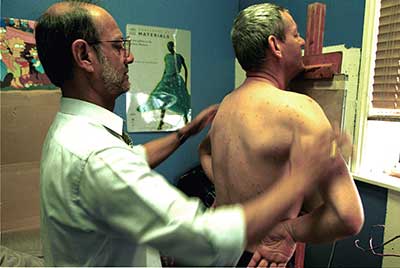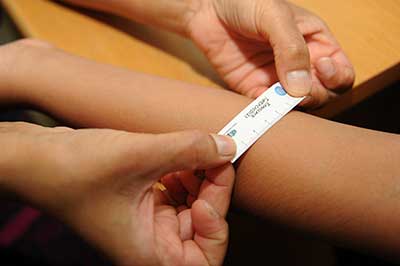There are several tests available that can be used to diagnose tuberculosis, depending on the type of TB suspected and the resources available for testing.
Culture test
A sample of bodily fluid or tissue is taken from someone with suspected TB. For suspected pulmonary TB, sputum (phlegm) may be collected in a jar. If TB is thought to be in another area of the body, a biopsy may be performed.
Any bacteria present in the sample can be grown in a culture, under laboratory conditions. Culture tests are very reliable, and can also help determine the right medication for the type of TB found as they can differentiate between drug resistant or drug sensitive TB.
 Chest X-ray
Chest X-ray
A chest X-ray can identify damage to the lungs, an indicator of pulmonary TB. If damage is spotted, further testing is necessary to prove TB is the cause.
Sputum smear microscopy
If a patient has a cough that produces sputum, a sample may be looked at under a microscope. Visible TB germs indicate an active TB infection in the lungs and throat – sputum smear positive TB. This form of TB is also known as pulmonary TB, which is the only infectious form of the illness.
If TB bacteria are not visible, this does not mean that TB is not present. There may simply be too few bacteria to be visible. A culture test is needed to clarify this.
GeneXpert
The GeneXpert system can identify TB bacteria from sputum samples. It is also able to test whether any TB bacteria present is resistant to rifampicin (RIF) – a frontline TB drug. The system is cartridge-based, easy to use and provides results in 90 minutes. In 2010, WHO endorsed the product for use in TB endemic countries.
The test is more sensitive than sputum smear microscopy, but less sensitive than a culture. It is of limited effectiveness in children, people with low CD4 counts (most often people living with HIV) and people with extra pulmonary disease — because they have fewer bacteria in their sputum.
 TB skin test
TB skin test
A tuberculin skin test (TST) – or Mantoux test – checks the immune system’s response to TB bacteria. A tiny amount of tuberculin extract is injected under the skin. If the immune system has come into contact with TB the skin becomes raised and red. However, a positive result does not confirm an active infection. Further testing is required. Latent TB and a history of BCG vaccination will also cause a reaction.
Blood test
A TB blood test is a reliable indicator of a TB infection. Results can be provided in just one visit to a clinic. However, a positive result does not indicate whether an infection is latent or active. Further tests are necessary to clarify this. There are currently two types of blood test technology, QuantiFERON and T-SPOT.TB.

 Chest X-ray
Chest X-ray TB skin test
TB skin test